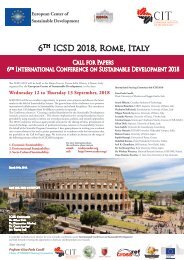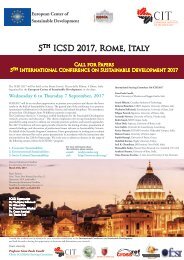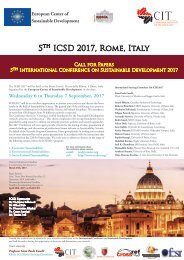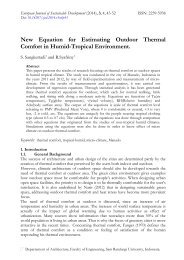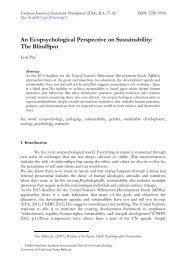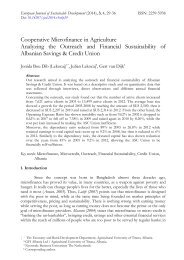Emergy evaluation of a traditional farming system. Case study: Leh District (Ladakh - Indian Trans-Himalaya)
Ladakh traditional farming system has been included on the F.A.O. list of possible “Globally Important Agricultural Heritage Systems”, worthy of being preserved and conserved. The paper describes and assesses cultivation practices in a typical familymanaged farm, located in central Ladakh, analysing how natural resources are exploited, conserved and recycled. Emergy evaluation, an environmental accounting methodology, has been applied to evaluate and compare five staple crop productions: barley, wheat, pea, mustard, and fodder alfalfa. Unit Emergy Values of products (UEV, emergy per unit product, a measure of the environmental production cost) are calculated, taking into account the inputs to production such as water from glaciers, soil fertility, human and animal labour, and more. Results show that the traditional agricultural practices in Ladakh, completely supported by renewable flows, are efficient in the use of local resources. In fact, the UEVs of agroproducts are similar to those of analogous products of conventional agriculture (e.g. 5.27E+05 and 6.64E+05 semj/J for barley and wheat in Ladakh, respectively; 7.37E+05 semj/J for corn in USA), though the inputs of Ladakh agriculture are strongly limited in type and quantity. At the same time, local farmers can create, maintain and rebuild soil functions whose UEV is 1.62E+07 semj/J. Keywords: Ladakh, agrosystem, emergy, environment, sustainability
Ladakh traditional farming system has been included on the F.A.O. list of possible “Globally Important Agricultural Heritage Systems”, worthy of being preserved and
conserved. The paper describes and assesses cultivation practices in a typical familymanaged farm, located in central Ladakh, analysing how natural resources are exploited, conserved and recycled. Emergy evaluation, an environmental accounting methodology, has been applied to evaluate and compare five staple crop productions: barley, wheat, pea, mustard, and fodder alfalfa. Unit Emergy Values of products (UEV, emergy per unit product, a measure of the environmental production cost) are calculated, taking into account the inputs to production such as water from glaciers, soil fertility, human and
animal labour, and more. Results show that the traditional agricultural practices in Ladakh,
completely supported by renewable flows, are efficient in the use of local resources. In fact, the UEVs of agroproducts are similar to those of analogous products of conventional agriculture (e.g. 5.27E+05 and 6.64E+05 semj/J for barley and wheat in Ladakh, respectively; 7.37E+05 semj/J for corn in USA), though the inputs of Ladakh agriculture are strongly limited in type and quantity. At the same time, local farmers can create, maintain and rebuild soil functions whose UEV is 1.62E+07 semj/J.
Keywords: Ladakh, agrosystem, emergy, environment, sustainability
You also want an ePaper? Increase the reach of your titles
YUMPU automatically turns print PDFs into web optimized ePapers that Google loves.
V. Pelliciardi, L. Varvaro, F. M. Pulselli 9<br />
16.9 q/ha and 6.4 q/ha (DAC, 2006). However, yields depend on a number <strong>of</strong> factors<br />
that can vary from place to place, and the comparison between values <strong>of</strong> mountain and<br />
plain agriculture is still under debate. Some <strong>Indian</strong> scientists (Singh, 1992; Kaul, 1998;<br />
Jodha et al. 1999) and Government <strong>of</strong>ficials 1 from the plain consider the <strong>traditional</strong> local<br />
<strong>farming</strong> <strong>system</strong> backward and unproductive with very low yield potentialities 2 . On the<br />
other hand, the <strong>Leh</strong> Agriculture Department and other independent international<br />
researchers report better performances <strong>of</strong> the <strong>system</strong> (Demenge, 2007; Osmaston, 1994;<br />
Mankelow, 2003). Therefore, this <strong>system</strong> is designed in such a way that few inputs from<br />
the environment are converted into a above average quantity <strong>of</strong> agroproducts that are<br />
essential for supporting the population. Regarding the use <strong>of</strong> fertilizers, for example,<br />
Manjula (2007) states that “in spite <strong>of</strong> the established excellence <strong>of</strong> the <strong>traditional</strong><br />
<strong>Ladakh</strong>i crop, <strong>of</strong>ficial policy has taken for granted that it could be improved by the use<br />
<strong>of</strong> chemical fertilisers and the introduction <strong>of</strong> high yielding varieties <strong>of</strong> crops”. However,<br />
local farmer community uses agricultural chemicals with caution (Sagwal, 1991), or in a<br />
mix with manure, at least in rural areas while near the town <strong>of</strong> <strong>Leh</strong> greater use <strong>of</strong><br />
inorganic fertilizers has been reported (Manjula, 2007). Unfortunately, by attempting to<br />
transform agriculture into a more modern activity, the <strong>Leh</strong> <strong>District</strong> risks losing the<br />
eco<strong>system</strong> configuration <strong>of</strong> the <strong>traditional</strong> agroproduction <strong>system</strong>.<br />
4.1. Resource management<br />
The inputs to the <strong>traditional</strong> agricultural <strong>system</strong> are the natural resources<br />
provided for free by the environment. This kind <strong>of</strong> <strong>system</strong> has been able, for a very long<br />
time, to produce, select and recycle all the matter and energy necessary for the activity to<br />
be maintained continuously. In other words, it seems that local human activity has always<br />
been well integrated within the eco<strong>system</strong> dynamics, using resources without<br />
compromising their availability and closing cycles. Problems related to resource scarcity<br />
and unfertile soil have been tackled through careful management and social control, the<br />
latter meaning a fair distribution <strong>of</strong> environmental wealth (e.g. water and land).<br />
“Renewability” is the keyword <strong>of</strong> the <strong>Ladakh</strong>i attitude; at the same time, local nonrenewable<br />
natural capital is not <strong>system</strong>atically depleted (e.g. in the form <strong>of</strong> loss <strong>of</strong> soil<br />
functions). This is possible by virtue <strong>of</strong> a set <strong>of</strong> consolidated techniques: manure<br />
returning/recycling technology, area management through a <strong>system</strong> <strong>of</strong> manmade<br />
terraces, the use <strong>of</strong> straw and fodder to feed the animals, and negligible production and<br />
efficient disposal <strong>of</strong> wastes.<br />
The fact that few inputs are used to generate agroproducts for people’s subsistence<br />
implies that the vulnerability, as a lack <strong>of</strong> resource redundancy, <strong>of</strong> this <strong>system</strong> must also<br />
be taken into consideration. In fact, beyond the elements that characterize the typical<br />
1 “The harsh environment and apparently simple subsistence agriculture in Zanskar [<strong>Ladakh</strong><br />
province/block] have led most visitors and government <strong>of</strong>ficials to assume that the local crops<br />
are rather unproductive.” (Osmaston, 1994).<br />
2 J&K Crop Production Statistics for the Year 1999-2000 to 2006-2007 reports average yield for<br />
wheat and barley in the <strong>Leh</strong> <strong>District</strong> at only 9.0 q/ha and 14.8 q/ha; see also Krishi Vigyan<br />
Kendra, 6 th Scientific Advisory Committee Meeting Report, <strong>Leh</strong> 2006, “Area, Production and<br />
Productivity <strong>of</strong> major crops cultivated in the <strong>District</strong>”, pg. 11, unpublished document.<br />
© 2014 The Authors. Journal Compilation © 2014 European Center <strong>of</strong> Sustainable Development.




